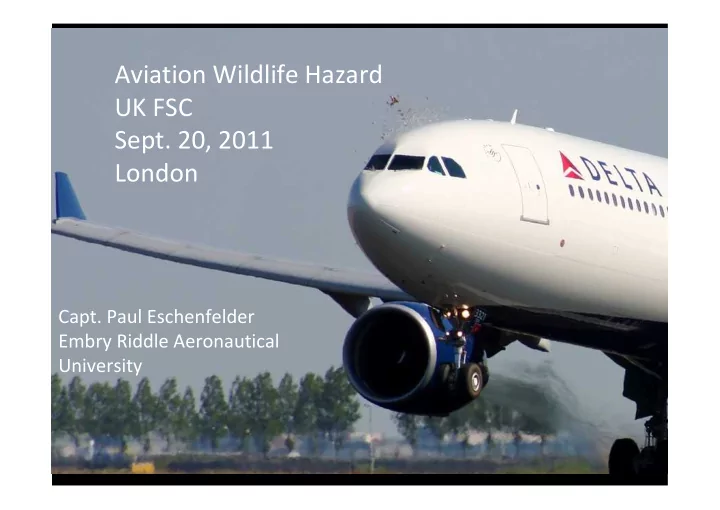

Aviation Wildlife Hazard UK FSC Sept. 20, 2011 London Capt. Paul Eschenfelder Embry Riddle Aeronautical University
Air Berlin B737-700 vs. geese April 2010
Hong Kong – – 2010 2010 Hong Kong Second helo destroyed in two Second helo destroyed in two years years
IBSC estimate: Cost to operators worldwide: $1-1.5 Billion Annual cost: direct repair, out of service, Customer accommodation
50% of unscheduled engine removal show bird ingestion damage
Brussels Bird Control Unit: •Part-time leader •NO training for bird control people – hunting license only
Rome 2007 – Delta B767 *Crew saw the birds on taxiout •Crew discussed the birds •Crew never reported the birds •Crew never asked for a bird scare before takeoff •Crew took off anyhow, damaged both engines severel y
$10,000,000 Event for DL but……
ETOPS/LROPS? • Cyprus Air – A330 Lanarca-Heathrow • Qantas - B767 Melbourne-Sidney • Thomas Cook – B757 Istanbul-London • Arik Air – B737 Owerri-Lagos • BA 747 – Orlando-Gatwick • Delta 767 – Madrid-Madrid • PAL 777 – Manila-Vancouver
• USAir 320 – destroyed, 2009 • Ryanair B737 – destroyed, 2008 • KLM B737 – destroyed 2004 • Falcon 20 – destroyed, 2007 • Citation – destroyed, 2009 • Sikorsky helo – destroyed, 2009
FAA’s position? Mike O’donnell, Director, Airport Safety and Standards: “The FAA at no time considers birds a severe or serious hazard”. Summer, 2010 Last four years: 11 dual engine ingestions
Resident Canada Goose populations – North America No. of Geese (x 1 Million) 0.0 0.5 1.0 1.5 2.0 2.5 3.0 3.5 1970 1972 1974 1976 1978 1980 1982 1984 1986 1988 1990 1992 1994 1996 1998 2000
Engine standards today • Single four (4) pound bird • Can’t blow up • Can’t catch fire • Can’t tear off the wing • Must be able to be shut down • What’s missing?
The 36 Bird Species in N. America with Mean Body Masses >4 lbs Rank Species Mass (lbs) 1 Mute swan 26.01 2 Trumpeter swan 25.13 3 California condor 22.28 4 Wild turkey 16.31 5 Tundra swan 15.65 6 American white pelican 15.43 7 Whooping crane 12.84 8 Sandhill crane 12.78 9 Yellow-billed loon 12.13 10 Bald eagle 11.79 11 Golden eagle 10.83 12 Canada goose 9.22 13 Common loon 9.11 14 Brown pelican 8.16
F = (½ mass) times (velocity squared)
DH- 8 blades
Is wildlife a hazard to aviation? Hazard? Risk?
Is wildlife a hazard? • “Cleared to land – mind the truck on the runway” • “Cleared to land – mind the birds on the runway”
The ‘Swiss cheese’ model of an accident (Crash of SA 227 in Scotland 2002) Bird Strike Hazards Birds on airport Pilot error Losses Mechanical Failure
FLY FLY
Use caution for the birds! Uhhhh, how do we do that?
• USAir 320 – destroyed, 2009 • Ryanair B737 – destroyed, 2008 • KLM B737- destroyed, 2004 • Falcon 20 – destroyed, 2007 • Citation – destroyed, 2009 • Sikorsky helo – destroyed, 2009
• Defined the problem • Developed mitigation • Developed policy for mitigation integration • Trained the policy • Implemented policy
We are looking to you for help We need: Training, policy guidance and oversight
How to ‘use caution for the birds’ • Give SPECIFIC WARNINGS – ‘Use caution for flock of gulls at 18L touchdown zone’ • Name the threat (gulls, geese, starlings) • Give the location! • Statement? Or Warning?
• Where are the birds – what altitude? • 95% of birdstrikes happen below 3,000’ • Why aren’t we using segregation & avoidance?
“Use Caution” – On approach • Remain above 3,000’ until necessary to descend to land • Reduce airspeed • Reduce engine speed
“Use Caution” – on departure • DON’T TAKEOFF INTO HAZARDS! • Climb on ICAO NADP 1 or best angle of climb until 3,000’ • Skip the sightseeing – watch out for hazards
Where can we find this guidance? • Transport Canada – ‘Sharing the Skies’ • UK CAA AIC 28/2004 • EU EASA ‘Skybrary’ – ‘Operator’s Checklist’ • Airbus – Briefing Notes
What’s needed? 1. Industry standards/policy/regulation 2. Training 3. Integrated comprehensive plan
Use by permission only
Recommend
More recommend